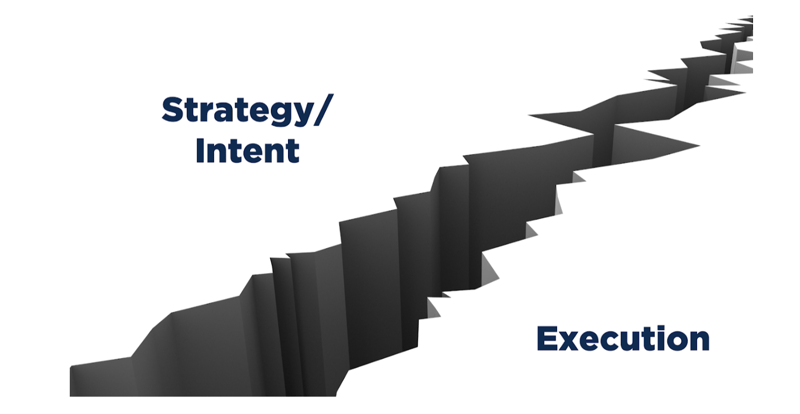 Back when one of my kids was still a teenager, I remember her saying her legs hurt. Two days later, her pants were two inches too short.
Back when one of my kids was still a teenager, I remember her saying her legs hurt. Two days later, her pants were two inches too short.
Growth is painful, hard, and often uneven. While a teenager’s growing pains are literal, a company’s is figurative—but it’s no less real. Growth and pain go together for a reason. For businesses, that pain is often due (as I explain in this blog) to a growing chasm between the strategy and intent of a company and the execution. One of the reasons for this is the fact that the language of strategy and the language of execution differ greatly.

To have sustainable, scalable growth, your company must bridge that chasm between strategy and execution. There are two ways to do that: working harder (increasing force) or minimizing disorder (reducing friction). Since every business reaches a point where employees just can’t work harder, that leaves reducing friction.
The key to making growth manageable and predictable is to manage the friction.
So, how do you manage friction? There are a number of ways and the good news is that all the methods can build on each other.
1. System Design - System design combines your system requirements with design thinking. This creates the ongoing process of making the trade-offs and adjustments necessary to align all vectors within your organization to maximize value creation within the constraints that exist for you.
This is what Imagine calls “blue work” or strategic work—and it’s very important. You don’t want to rush into execution before you understand the “job to be done” or what you want your system to accomplish.
Once that’s accomplished, you must design and maintain the systems, structures, and disciplines that mitigate the complexity and friction that naturally increases in an organization.
If you’re interested in learning more, don’t miss Imagine’s podcast on system design.
2. Technology/tech stack/CRM - This is what a lot of people believe is the end result of RevOps, but it’s not. Technology is merely a tool to help you achieve your goals. The modern sales and marketing playbook promised greater insights and acceleration as data and technology became more prevalent. Yet, despite record sums being spent on sales and marketing technology, strong results are harder and harder to come by.
That’s because the business process should drive the technology—but for many companies, it works in reverse. As we like to say at Imagine, “Don’t buy technology; hire it.” Figure out the “job to be done” and “hire” technology that will help your employees accomplish that job.
The tech stack should be driven by your goals and your strategy and playbook. It should span all aspects of your customer acquisition.
If you don’t get your goals, strategy, and playbook straight before you put together your tech stack, you’ll often get a “Frankenstein” result; in other words, a mish-mash of tech that isn’t designed to work together and that doesn’t give you the desired results. (For a more in-depth take, check out our webinar, Unlock the Latent Power of Your CRM, Marketing Automation & DemandGen Tech Stack.)
3. Consistent execution - You’ve probably heard the saying “Execution eats strategy for lunch.” What that means is that the “best” strategy is the one your business can easily and consistently execute. While in theory, there may be a “perfect” strategy out there, too many companies spend time trying to perfect their strategy instead of spending the time perfecting execution. What you want is a simple, highly repeatable strategy that delights customers and adds value for investors.
If you’ve been following along, this is another way of managing friction. This model allows your company to grow with less friction and more velocity. It makes it easier to scale any expansions.
One thing you can do to ensure your execution is strong is to select and measure certain KPIs. (We do a deep dive in this podcast.) As I like to say, “What gets measured gets done.” And, as I wrote in this blog, if you’re not measuring KPIs, you’re wasting money and seeing an opportunity cost.
4. A blend of effort and outcome - Workplaces often often view growth through one of two lenses:
- The paradigm of quantity, which focuses on activity and effort
- The paradigm of quality, which focuses on outcomes.
At Imagine, we believe the best outcomes result from focusing on a blend of both. (Admittedly, that realization took some time and experience to fully click.)
So, how can you ensure you’re getting the ideal blend of both? There are a few ways:
- “Is the juice worth the squeeze?” - This is perhaps my favorite “Dougism,” as my employees call my sayings—and for good reason. What this question is really asking is “Is the effort worth the outcome?” The effort can be measured in different types of friction: time, money, opportunity costs, stress levels, and more. If you’re focused on growth, your best bet is likely on the highly repeatable execution mentioned above. If not, you need to ask if the juice is worth the squeeze.
- The 80/20 principle - This is known as the Pareto Principle, which states that 80% of outcomes result from 20% of all causes. This circles back to “Is the juice worth the squeeze?” In other words, you should be concentrating your efforts on what works—even more than that, you should be intensively concentrating on that 20%. Focus on what’s working!
- Define your ideal client profile - Many companies who think they have ideal client profiles actually don’t. Companies should be asking “Who do we want to be a hero to?” I strongly believe you need to define “who” before you can answer “why” or many other questions. You can’t build strategy, let alone work on lessening friction, until you know “who.” That means you can’t grow, at least not efficiently and consistently. You need to develop an ideal client profile and then, to use a bowling analogy, take targeted aim at 1.5 pins to have a shot at knocking them all down.
- Use the jobs to be done approach - Customers don’t simply buy a product or service—they “hire” it to do a job. For example, customers who want takeout but don’t want to leave the house and don’t want to go through the laborious process of placing a phone order “hire” Seamless to make the ordering process, well, seamless (at least most of the time). If you want growth, you must understand what customers are hiring it to do. Then, you will be able to better understand how to market it to the right audience.
By now, you may have gathered that the key to growing effectively—reducing friction—has many moving parts. While consistent execution is more important than developing the “perfect” strategy, it’s important to do the work upfront to determine who you’re targeting and what they’re hiring you to do. Once all that is clear, a focus on execution will help you scale efficiently. Growth always has some degree of mess and pain, but forethought and planning can make it easier.

 Doug Davidoff
Doug Davidoff
